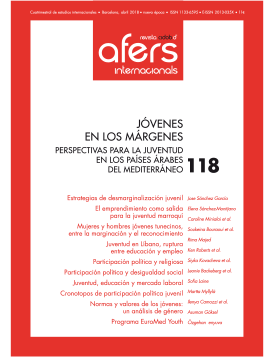Born to be exported? Youth in Lebanon, rupture between education and employment
Keywords:
Lebanon, youth, unemployment, education, inequalities, migrationAbstract
Revista CIDOB d’Afers Internacionals, nº 118
Quadrimestral (January-April 2018)
ISSN:1133-6595 | E-ISSN:2013-035X
DOI: doi.org/10.24241/rcai.2018.118.1.77
The lack of job opportunities for the young has been a defining feature of Lebanon since its creation, but in the post-civil war era (after 1990) the situation has worsened with the neoliberal transformations that have encouraged the so-called "jobless growth", the services sector and sectarian clientelism. This article examines the conditions of youth marginalisation by studying the relationship between structural changes, education, youth employment and migration in Lebanon based on the results of the SAHWA Project (ethnographic fieldwork and survey) carried out in three of the country's regions in 2015. As a result, it argues that structural inequalities and those in the access to quality education have led to social reproduction, limited the opportunities for social mobility and deepened the marginalisation of youth. Hence, more than a mismatch between education and employment, in Lebanon there seems to be a complete "rupture" between the two.
>> The full text articles of this issue are available only in Spanish language
References
AbiYaghi, Marie-Noëlle, Myriam Catusse y Miriam Younes. «From isqat annizam at-ta’ifi to the Garbage Crisis Movement: Political Identities and Antisectarian Movements». En: Di Peri, Rosita y Meier, Daniel (eds.). Lebanon Facing The Arab Uprisings. United Kingdom: Palgrave Macmillan UK, 2017, p. 73-91.
Abou Jaoude, Hicham. Labour Market and Employment Policy in Lebanon. European Training Foundation (ETF), 2015 (en línea) [Fecha de consulta: 17.04.2017] http://www.etf.europa.eu/webatt.nsf/0/33A1850E6A358308C1257DFF005942FE/$file/Employment%20policies_Lebanon.pdf
Abu-Rish, Ziad. «Garbage politics». Middle East Report, vol. 45, n.º 277 (2015) (en línea) [Fecha de consulta: 17.04.2017] http://www.merip.org/mer/mer277/garbage-politics
ANND-Arab NGOs Network for Development. Arab Watch Report on Informal Employment 2016 (2017) (en línea) [Fecha de consulta: 27.02.2018] http://www.annd.org/cd/arabwatch2016/pdf/english/report.pdf
Banco Mundial (World Bank). «Republic Of Lebanon-Good Jobs Needed: The Role of Macro, Investment, Education, Labor and Social Protection Policies». World Bank Report, n.º 76008-LB (2012) (en línea) [Fecha de consulta: 02.04.2017] https://openknowledge.worldbank.org/handle/10986/13217
Baumann, Hannes. «The “New Contractor Bourgeoisie” in Lebanese Politics: Hariri, Mikati and Fares». En: Knudsen, Are y Kerr, Michel (eds.). Lebanon: After the Cedar Revolution. Londres: Hurst & Company, 2012, p. 125-144.
Baumann, Hannes. Citizen Hariri and neoliberal politics in postwar Lebanon. Tesis de doctorado, University of London, 2012 (en línea) [Fecha de consulta: 18.04.2017] http://ethos.bl.uk/OrderDetails.do?uin=uk.bl.ethos.574463
Bayat, Asef. Life as politics: How ordinary people change the Middle East. Stanford: Stanford University Press, 2013.
Bourdieu, Pierre. «Cultural Reproduction and Social Reproduction». En: Karabel, Jerome y Halsey, A.H. (eds.). Power and Ideology in Education. Nueva York: Oxford University Press. 1977, p. 487-511.
Bourdieu, Pierre. «The forms of capital». En: Richardson, John (ed.). Handbook of theory and research for the sociology of education. Nueva York: Greenwood Press, 1986, p. 241-258.
Cammett, Melani. Compassionate Communalism: Welfare and Sectarianism in Lebanon: Ithaca: Cornell University Press, 2014.
Chaaban, Jad. «Labour markets performance and migration flows in Lebanon». European Economy Occasional Papers, n.º 60, vol. 3, 2010, p. 157-200.
CRI-Consultation & Research Institute. School to Work transitions of young women and men in Lebanon 2014-2015 [Draft Report]. CRI, 2015.
Davis, Kathy. «Intersectionality as buzzword: A sociology of science perspective on what makes a feminist theory successful». Feminist theory, vol. 9, n.º 1 (2008), p. 67-85.
De Bel-Air, Françoise. Migration profile: Lebanon. European University Institute, RSCAS Policy Briefs, 2017 (en línea) [Fecha de consulta: 10.12.2017] http://cadmus.eui.eu/handle/1814/46504
Dibeh, Ghassan. The Political Economy of Postwar Reconstruction in Lebanon. UNUWIDER, Research paper, 2005 (en línea) [Fecha de consulta: 08.04.2017] https://www.econstor.eu/bitstream/10419/63472/1/500825963.pdf
Dibeh, Ghassan; Fakih, Ali y Marrouch, Walid. The Poor and Marginalized in Lebanon: Labor Market Challenges and Policy Implications. CIDOB Sahwa Policy Paper, n.º 1 (2016) (en línea) [Fecha de consulta: 15.05.2017] http://www.sahwa.eu/NEWS/SAHWA-s-Policy-Paper-on-labour-market-inLebanon-now-online
Dibeh, Ghassan; Fakih, Ali y Marrouch, Walid. «Decision to Emigrate Amongst the Youth in Lebanon». International Migration, vol. 56, n.º 1 (2018), p. 5-22.
El-Ghali, Hana A. The role of higher education institutions in addressing youth unemployment in Lebanon. Tesis de doctorado, University of Pittsburgh, 2011.
Fakih, Ali y Marrouch, Walid. «The electricity consumption, employment and growth nexus: evidence from Lebanon». OPEC Energy Review, vol. 39, n.º 3 (2015) p. 298-321.
Frayha, Nemer. The Education Centre for Research and Development in 1017 days [en árabe]. Beirut: Dar Al-Ibdaa, 2003.
Göksel, Asuman; Şenyuva, Özgehan y Güngen, Sümercan B. «Redefining and Tackling (Youth) Unemployement in the Arab Mditerranean Context». Sahwa Policy Paper, 2016 (en línea) [Fecha de consulta: 29.06.2017] http://sahwa.eu/OUTPUTS/SAHWA-Policy-Papers-ISSN-2564-9167/SAHWA-s-PolicyPaper-on-youth-unemployment-in-the-AMCs-now-online
Harris, William. Lebanon: a history, 600-2011. Oxford: Oxford University Press, 2012.
Herrera, Linda. «The Precarity of Youth: Entrepreneurship is not the Solution». Madamasr, 11 de febrero de 2017 (en línea) [Fecha de consulta: 20.05.2017]
Hoffman, Michael y Jamal, Amaney. «The youth and the Arab spring: cohort differences and similarities». Middle East Law and Governance, vol. 4, n.º 1 (2012), p. 168-188.
Kasparian, Choghig. «L’émigration des jeunes Libanais hautement qualifiés. Notes d’analyse et de synthèse». European University Institute, CARIM Notes d’analyse et de synthèse, n.º 10 (2010) (en línea) [Fecha de consulta: 19.04.2017] http://cadmus.eui.eu/bitstream/handle/1814/13445/CARIM_ASN_2010_10.pdf?sequence=1&isAllowed=y
Kawar, Mary y Tzannatos, Zafiris. «Youth Employment in Lebanon: Skilled and Jobless». LCPS Policy Paper, 2013 (en línea) [Fecha de consulta: 02.04.2017] http://www.lcps-lebanon.org/publications/1368538726-youth_enemployment.pdf
Kerbage, Carole. «Politics of Coincidence: The Harak Confronts its People». IFI Working Papers, n.º 41 (2017) (en línea) [Fecha de consulta: 10.12.2017] https://website.aub.edu.lb/ifi/publications/Documents/working_papers/20170213_wp_hirak_english.pdf
Kraidy, Marwan M. «Trashing the sectarian system? Lebanon’s “You Stink” movement and the making of affective publics». Communication and the Public, vol. 1, n.º 1 (2016), p. 19-26.
LAU-Lebanese American University. «National Case Study-Lebanon». SAHWA National Case Studies, NCS-LB (2016) (en línea) [Fecha de consulta: 02.04.2017] http://sahwa.eu/content/download/1428/10757/file/LB.pdf
Leenders, Reinoud. Spoils of truce: Corruption and state-building in postwar Lebanon. Ithaca: Cornell University Press, 2012.
Makarem, Hadi. Actually Existing Neoliberalism: The reconstruction of Downtown Beirut in post-civil war Lebanon. Tesis doctoral, London School of Economics and Political Science, 2014 (en línea) [Fecha de consulta: 02.04.2017] http://etheses.lse.ac.uk/3078/1/Makarem_Actually_Existing_Neoliberalism.pdf
Meier, Daniel. «Popular Mobilizations in Lebanon: From Anti-system to Sectarian Claims». Democracy and Security, vol. 11, n.º 2 (2015), p. 176-189.
Nahas, Charbel. «Financing and political economy of higher education: The case of Lebanon». Prospects: Quarterly Review of Comparative Education, vol. 41, n.º 1 (2011), p. 69-95.
Nizameddin, Talal. «The political economy of Lebanon under Rafiq Hariri: An interpretation». The Middle East Journal, vol. 60, n.º 1 (2006), p. 95-114.
OIT-Organización Internacional del Trabajo (ILO-International Labour Organization). «Youth unemployment in the Arab World is a major cause for rebellion». ILO Newsroom, 5 de abril de 2011 (en línea) [Fecha de consulta: 02.04.2017] http://www.ilo.org/global/about-the-ilo/newsroom/features/WCMS_154078/lang--en/index.htm
OIT-Organización Internacional del Trabajo (ILO-International Labour Organization). Assessment of the Impact of Syrian Refugees in Lebanon and their Employment Profile. Beirut: ILO-ROAS, 2014 (en línea) [Fecha de consulta:
04.2017] http://www.ilo.org/wcmsp5/groups/public/@arabstates/@robeirut/documents/publication/wcms_240134.pdf
OIT-Organización Internacional del Trabajo (ILO-International Labour Organization). Global Employment Trends for Youth 2015: Scaling Up Investments in Decent Jobs for Youth. Ginebra: ILO, 2015a (en línea) [Fecha de consulta: 02.04.2017] http://www.ilo.org/wcmsp5/groups/public/---dgreports/---dcomm/---publ/documents/publication/wcms_412015.pdf
OIT-Organización Internacional del Trabajo (ILO-International Labour Organization). «MENA region retains highest youth unemployment rate in the world». ILO News, 8 de octubre 2015b (en línea) [Fecha de consulta: 02.04.2017] http://www.ilo.org/beirut/media-centre/news/WCMS_412797/lang--en/index.htm
Picard, Elizabeth. «The Political Economy of Civil War in Lebanon». En: Heydemann, Steven (ed.). War, Institutions and Social Change in the Middle East. Berkeley: University of California Press, 2000, p. 292-322.
Sánchez García, José; Feixa Pampols, Carles y Laine, Sofia. «Contemporary Youth Research in Arab Mediterranean Countries: Mixing Qualitative and Quantitative Methodologies». SAHWA Concept Paper, n.º 1 (2014) (en línea) [Fecha de consulta: 29.06.2017] http://sahwa.eu/OUTPUTS/Other-publications/SAHWA-Concept-Paper-Contemporary-YouthResearch-in-Arab-Mediterranean-Countries-Mixing-Qualitative-andQuantitative-Research PNUD/MoSA (UNDP/MoSA-United Nations Development Program/
Ministry of Social Affairs). Poverty, Growth, and Income distribution in Lebanon. Beirut: UNDP, 2008 (en línea) [Fecha de consulta: 15.03.2017] http://www.lb.undp.org/content/dam/lebanon/docs/Poverty/Publications/Poverty,%20Growth%20and%20Income%20Distribution%20in%20Lebanon.pdf
PNUD (UNDP-United Nations Development Program). رود سلجم باونلا ناجللاو Fecha) [línea en (2013 ,UNDP . تايصوتو ةسارد ،بابشلل لمعلا صرف ةدايز يف ةيباينلا de consulta: 07.03.2017] https://www.lp.gov.lb/Resources/Files/8416db08-8d5f-4a64-bb7b-421943d74574.pdf
PNUD (UNDP-United Nations Development Program). Arab Human Development Report 2016. Youth and the Prospects for Human Development in a Changing Reality. Nueva York: UNDP, 2016 (en línea) [Fecha de consulta: 07.03.2017] http://www.arab-hdr.org/reports/2016/english/AHDR2016En.pdf?download
Sánchez-Montijano y Girona-Raventós, M. «Arab Mediterranean youth migration. Who wants to leave, and why? ». EuroMesco Policy brief, n.º 73, (2017).
Sánchez-Montijano, Elena; Martínez, Irene; Bourekba, Moussa y Dal Zotto, Elena. SAHWA. Youth Survey 2016 Descriptive Report. Barcelona: CIDOB, 2017.
Tabar, Paul. Lebanon: A country of Emigration and Immigration. Beirut: LAU Press, 2010.
Traboulsi, Fawwaz. A History of Modern Lebanon. Londres: Pluto Press, 2012.
Unicef-United Nations International Children’s Emergency Fund. Education for Children and Adolescents in Lebanon: A Human Rights-Based, Equity-Focused Analysis of the Situation [Borrador no publicado]. UNICEF, MEHE y CRI, agosto de 2013.












